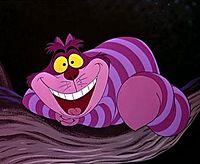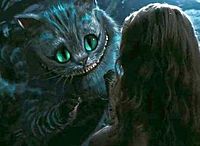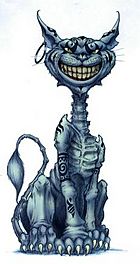Cheshire Cat facts for kids
Quick facts for kids Cheshire Cat |
|
|---|---|
| Alice's Adventures in Wonderland character | |
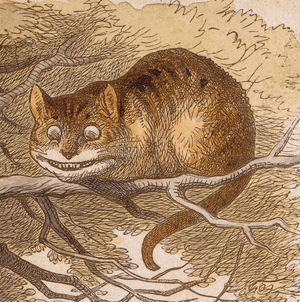
The Cheshire Cat as illustrator John Tenniel depicted it in the 1865 publication
|
|
| Created by | Lewis Carroll |
| Information | |
| Species | Tabby British Shorthair Cat |
| Gender | Male (the Queen of Hearts cries "off with his head" when the cat upsets the king) |
| Quote | "Most everyone's mad here." "You may have noticed that I'm not all there myself." |
The Cheshire Cat is a famous fictional cat from Lewis Carroll's book, Alice's Adventures in Wonderland. He is known for his big, mischievous grin and his amazing ability to disappear and reappear whenever he wants!
Even before Lewis Carroll wrote his book in 1865, people used the phrase "grinning like a Cheshire Cat." This cat has become super popular and appears in many places, from cartoons to TV shows and even in science discussions. One of the coolest things about the Cheshire Cat is how he slowly vanishes, leaving only his famous grin floating in the air!
Contents
Where did the Cheshire Cat idea come from?
The saying "grinning like a Cheshire Cat" has been around for a long time. It first appeared in a book in 1788. People used it to describe someone who was smiling so wide you could see their teeth and gums.
There are a few fun ideas about where this saying came from:
- Some people in Cheshire, a county in England, think cats there grin a lot because there's so much milk and cream from all the dairy farms!
- Another idea is that a sign painter in Cheshire tried to paint a lion, but it ended up looking more like a grinning cat. People started calling these signs "Cheshire cats."
- One theory suggests that cheese in Cheshire used to be shaped like a grinning cat. As people ate the cheese, the last part left was the smiling cat's head!
Lewis Carroll's famous character
The Cheshire Cat we know best is from Lewis Carroll's novel, Alice's Adventures in Wonderland. Alice first meets him at the Duchess's house. Later, she finds him sitting on a tree branch. He can appear and disappear whenever he likes, and he loves to have funny, sometimes confusing, chats with Alice.
The cat often asks Alice tricky questions that make her think. He even cheers her up when she's feeling down at the Queen of Hearts' croquet game. When the Queen orders the cat to be beheaded, he tricks everyone by making only his head appear without his body! This causes a big argument about whether you can chop off a head that isn't attached to a body. At one point, the cat slowly fades away until only his grin is left. Alice famously says she's "often seen a cat without a grin but never a grin without a cat."
Possible inspirations for the Cat's look

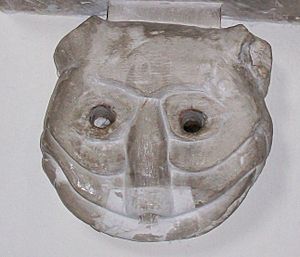
Some people think Lewis Carroll got the idea for the Cheshire Cat's grin from an old stone carving of a smiling cat. This carving is on a church tower in Grappenhall, a village not too far from where Carroll was born in Cheshire.
Carroll himself wrote that he saw a "Cheshire cat with a gigantic smile" carved into a wall at Brimstage Hall. This is another possible place he got his inspiration.
There's also a theory that the cat was inspired by a carving in a church in Croft-on-Tees, where Carroll's father was a priest.
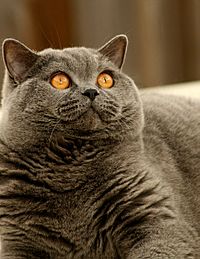
Another idea is that Carroll saw a picture of a British Shorthair cat on a label for Cheshire cheese. These cats are known for their round faces and sometimes look like they're smiling!
Cheshire Cat in movies and games
The Cheshire Cat has appeared in many movies, TV shows, and video games. Each time, he's shown in a slightly different way!
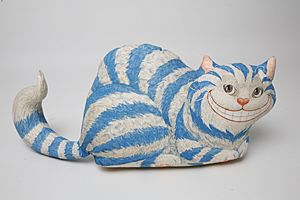
Before Disney made its famous animated movie in 1951, the Cheshire Cat wasn't mentioned much outside of Carroll's book. But in the 1960s and 1970s, he became much more popular, especially with songs like "White Rabbit" by Jefferson Airplane.
Different movie versions
- In Walt Disney's 1951 animated film, Alice in Wonderland, the Cheshire Cat is clever and loves to play tricks. He sometimes helps Alice, but he also gets her into trouble! He often sings a part of the "Jabberwocky" poem. He can make his head float away from his body and disappear, leaving only his grin or eyes.
- In the 1985 TV movie Alice in Wonderland, the Cheshire Cat sings a sad song about not finding a way home, which makes Alice want to find her way even more.
- In the 1999 TV movie Alice in Wonderland, the Cheshire Cat is a friend to Alice and helps her learn the "rules" of Wonderland. She loves to appear and disappear.
- In Tim Burton's 2010 live-action film, Alice in Wonderland, the Cheshire Cat is voiced by Stephen Fry. He helps Alice by healing her wound and guiding her to the Mad Hatter. He can disappear, change his size, float, and even pretend to be other characters. He often floats in the air and speaks in a slow, smooth voice.
The Cheshire Cat has also appeared in other TV shows, like Once Upon a Time in Wonderland. In this show, he's a giant cat who fights Alice until he's shrunk back to normal size.
Video games
- In the video games American McGee's Alice (2000) and Alice: Madness Returns (2011), the Cheshire Cat is a skinny, wise, but sarcastic guide for Alice. He helps her through a dark and twisted Wonderland.
- In the Japanese mobile game Alice's Warped Wonderland, the Cheshire Cat is a humanoid guide who helps Ariko (the game's Alice) find her memories. He can disappear, has super strength, and can even enter the real world. He is very caring towards Ariko, but in some endings, he can become very possessive if he absorbs too many of her sad feelings.
- In the dating sim game Heart no Kuni no Alice, the Cheshire Cat is a young man named Boris Airay, who has cat ears and a tail.
Other stories
The Cheshire Cat also shows up in other books, like Jasper Fforde's series, where he works for the literary police, and in Cheshire Crossing by Andy Weir. In the doll series Ever After High, the Cheshire Cat is a human woman, and her daughter, Kitty Cheshire, goes to a fairy tale high school.
Cheshire Cat in science
The idea of the Cheshire Cat, especially his disappearing act and his grin, has been used to describe some cool things in science!
- The Cheshire Cat effect is when you look at something with both eyes, but if something moves in front of one eye, part of the still object seems to disappear from your vision! It's like your brain focuses on the moving thing and makes the still part vanish.
- In physics, "The Cheshire Cat" is a strange idea in quantum mechanics. It's when a tiny particle and one of its properties (like its magnetism) act as if they are separated from each other! Scientists have done experiments that show this can happen.
- Astronomers have even nicknamed a group of galaxies the "Cheshire Cat galaxy group" because it looks like a grinning cat in space!
- In language studies, "cheshirization" is when a sound in a word disappears but leaves a small trace behind, just like the cat's grin.
Images for kids
See also
 In Spanish: Gato de Cheshire para niños
In Spanish: Gato de Cheshire para niños


